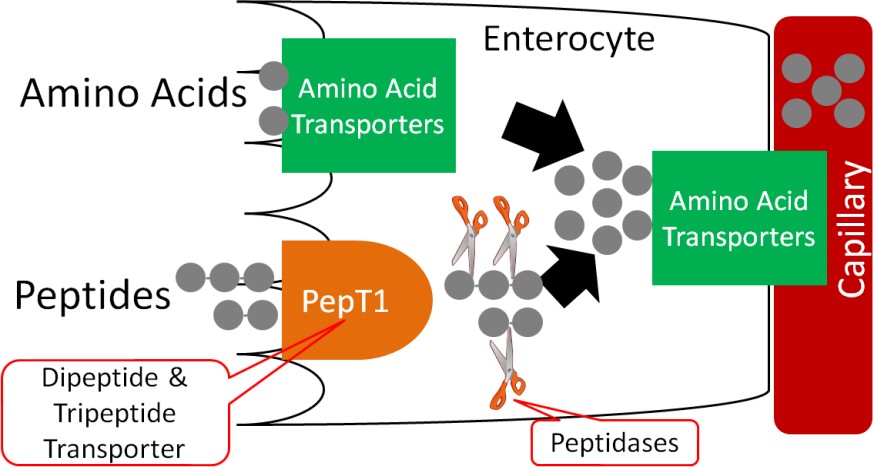13.2 Sodium
Sodium
Salt (NaCl) contributes almost all the sodium that we consume. 75-85% of the salt we consume is from processed foods, 10% is naturally in foods, and added salt contributes 10-15% of total salt intake1. Sodium is the major cation in extracellular fluid.
- % of consumed sodium is absorbed2. Sodium is taken up into the enterocyte through multiple mechanisms before being pumped out of the enterocyte by sodium-potassium (Na+/K+) ATPase. Sodium-potassium ATPase is an active carrier transporter that pumps 3 sodium ions out of the cell and 2 potassium ions into the cell, as shown below.

Figure 13.21 Sodium-potassium ATPase (aka sodium-potassium pump), an active carrier transporter3
Sodium has 3 main functions1:
- Fluid balance
- Aids in monosaccharide and amino acid absorption
- Muscle contraction and nerve transmission (will not discussed in this chapter however)
Fluid balance
The body regulates sodium and fluid levels through a series of processes as shown in Figure
- A decrease in plasma volume and blood pressure signals the kidney to release the enzyme renin. Renin activates angiotensin that is converted to angiotensin II. Angiotensin II signals the adrenal glands to secrete the hormone aldosterone. Aldosterone increases sodium reabsorption in the kidney, thus decreasing sodium excretion. These actions cause plasma sodium concentrations to increase, which is detected by the hypothalamus. The hypothalamus stimulates the pituitary gland to release antidiuretic hormone (ADH) that causes the kidneys to reabsorb water, decreasing water excretion. The net result is an increase in blood volume and blood pressure1.

Figure 13.22 Response to decreased plasma volume and blood pressure
Aids in monosaccharide and amino acid absorption
Glucose and galactose are taken up into the enterocyte by sodium-glucose cotransporter 1 (SGLT1), which requires sodium to be transported along with glucose or galactose.

Figure 13.23 Carbohydrate Absorption
Amino acids are taken up and transported into circulation through a variety of amino acid transporters. Some of these transporters are sodium-dependent (require sodium to transport amino acids).

Figure 13.24 Protein absorption
Sodium deficiency is rare, and is normally due to excessive sweating. Sweat loss must reach 2- 3% of body weight before sodium losses are a concern1,2. This situation can occur in marathon runners and ultra-marathon runners who sweat for many hours straight (without proper liquid intake). Low blood sodium levels (hyponatremia) can result in1:
- Headache
- Nausea
- Vomiting
- Fatigue
- Muscle Cramps
Hyponatremia can also result from water intoxication, a potentially fatal situation that can arise when too much water is consumed at one time. A decrease in sodium concentration can reduce osmolality outside of the cells and, therefore, increase the relative osmolality inside of the cells. As a consequence, cells swell as water moves in. This is a particularly dangerous situation in the brain. Swelling of brain tissue can result in an increase in intracranial pressure that can ultimately lead to cerebral edema and brainstem dysfunction.4
Sodium is not toxic, but higher sodium intake increases the risk of developing high blood pressure. High sodium intake also increases calcium excretion, but studies haven’t found an increased risk of osteoporosis. High sodium intake may also increase the risk of developing kidney stones (by increasing calcium excretion), because calcium oxalate is the most common form of kidney stone as reference in Chapter 91.
References & Links
- Byrd-Bredbenner C, Moe G, Beshgetoor D, Berning J. (2009) Wardlaw’s perspectives in nutrition. New York, NY: McGraw-Hill.
- Gropper SS, Smith JL, Groff JL. (2008) Advanced nutrition and human metabolism. Belmont, CA: Wadsworth Publishing.
- https://en.wikipedia.org/wiki/ATPase#/media/File:Scheme_sodium-potassium_pump-en.svg
- https://en.wikipedia.org/wiki/Water_intoxication

